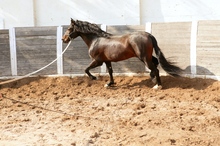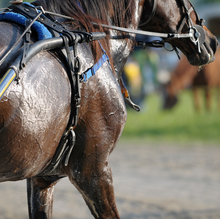Although all components of horse physiology are inter-related, energy production, heat and thermo regulation, fluid and electrolyte balance are especially significant in relationship to each other.
A horse's athletic activities are sustained by the conversion of chemical energy into mechanical energy. As the conversion takes place, heat becomes a by-product of energy metabolism. The generated heat combined with exercise causes the horse to sweat. As the horse sweats, the fluid and electrolyte balance in the horse's system change.
Equine energy production
Many factors influence the amount of energy needed by an individual horse including weight, general health condition, climate and weather and the horse's basic metabolism. Horses engaged in athletic activity require far more calories than pleasure horses. According to the National Research Council, energy requirements increase by 25, 50 and 100 percent for horses engaged in light, medium and intense work, respectively.
The calories eaten by the horse supply the horse's working muscles with a continuous supply of energy in the form of adenosine triphosphate (ATP). A series of chemical reactions catalyzed by enzymes are involved in aerobic metabolism. These chemical reactions produce energy from carbohydrates and fats. The higher the exercise intensity, the higher the use of carbohydrates in preference to fats in energy production.
Carbohydrates and fats ingested in excess of immediate requirements are stored in the horse's body for future use with carbohydrates stored as glycogen in the muscle fibers and liver. Fats are stored in muscle fibers as triglycerides and in the fatty tissues throughout the body.
Aerobic metabolism is dependent on a good blood supply to the muscles to deliver oxygen and energy and to remove waste products. When the muscular stores of glycogen are depleted, fatigue begins to affect the horse's performance. The horse then becomes dependent on fats as a source of energy and the rate of ATP synthesis slows forcing the horse to reduce the intensity or speed of the exercise.
Once the glycogen supply is exhausted, it take the horse approximately 48 hours to recover and replenish the glycogen in muscle fibers and the liver.
The aerobic system is the primary energy system in endurance sports that last several hours and in short duration events with low or moderate exercise intensity.

The horse's aerobic zone
The aerobic metabolism produces energy required for endurance and low to moderate exercise.
Anerobic alactic metabolism is the second important form of energy production. Also known as the "startup system" because the energy is immediately available at the beginning of exercise, it utilizes creatine phosphate in the metabolism process, does not produce lactate as a waste product, and does not require oxygen in the development of energy.
The anaerobic alactic system is the primary energy system in the early stages of exercise because it allows rapid acceleration and speed supported by creatine phosphate stored in the muscles, although there is s sharp drop-off after 10 to 20 seconds.
Calf roping, barrel racing, and jumping are examples of activities that rely heavily on anerobic alactic metabolism.
The third kind of metabolism involved in energy production is anaerobic lactic metabolism, which is also known as glycolysis and supports high intensity exercise over 1 to 2 minutes. With carbohydrates present in the muscles and liver in the form of glycogen, this system can kick in almost immediately when exercise starts.
Because it is relatively inefficient in the amount of ATP it produces, the anaerobic lactic system depletes the glycogen stores rapidly. Also, lactate, a toxic waste product of anaerobic lactic metabolism is produced faster than it can be used or removed, leading to an accumulation in the muscles fibers. It reduces the pH within the muscle fibers and slows down the chemical reactions responsible for energy production resulting in fatigue.
The blood lactate level is sometimes used as an indicator of fitness on the basis that, as fitness improves, a smaller rise in lactate after a standard amount of work is seen.
Anaerobic lactic metabolism is the primary energy system in sports that require a maximal effort for a period of 20 to 120 seconds. Racing, cutting, polo and jumping are examples of sports with short burst of intense activity that rely on the anaerobic lactic system.
Conditioning changes the structure and chemical composition of the muscle fibers and has a marked effect on the aerobic anaerobic capacity of the muscles. The muscles increase in size and weight and the chemical effects of conditioning involve changes in enzyme levels and in the amount of energy substrates stored within the muscle fibers.
Capillary density increases over a period of several months and helps facilitate diffusion of gases, nutrients and waste products enabling the horse's body to function more efficiently.
Equine heat and thermo regulation

The post race cool-down
The horse's metabolism produces heat as a by-product of work. Evaporation of sweat is one of four mechanisms to alleviate heat build-up.
As mentioned earlier, heat is a by-product of energy metabolism. A small rise in temperature is beneficial and enhances the power of muscular contractions while making the muscles, tendons and ligaments more pliable.
The nearly constant core temperature maintained by most horses represents a carefully controlled and critical balance between heat production, heat gain and heat loss. Cutaneous temperature-sensitive receptors and the hypothalamic temperature regulating center play a major role in the regulation of the horse's body temperature
Unfortunately, as the horse works at higher levels of intensity and for longer periods of time, excessive heat begins to build up and this affects not only performance, but may become life-threatening especially on hot, humid days.
When the horse becomes overheated, it needs to transfer heat from its body to the environment. This happens in four different ways:
- By means of radiation: heat leaves the body in the form of infrared rays; for this to occur, the horse's temperature has to be hotter than the air around it.
- By means of conduction: heat is transferred to a cooler surface such as a cold cement floor or to water sprayed or dabbed on the horse.
- By means of convection: as currents of air move over the horse's skin, heat and moisture is picked up and carried away as new air molecules come into contact with the skin and continue the process.
- By means of evaporation: as the horse sweats and the sweat becomes vapor, each gram of water uses about half a calorie of energy which comes from the horse's body in the form of heat.
Research shows that only about 25 percent of available chemical energy is convertible to energy used by the horse to sustain workload. The remaining energy is converted to heat with vigorous exercise resulting in massive metabolically generated heat load.
When exercise is performed in environments where temperature and/or humidity are high, the competing demands for evaporative cooling and maximum energy output may limit performance and may also lead to serious heat-associated disturbances in the horse's system. (Taylor, 1982)
Equine fluid and electrolyte balance
When compared to a horse at rest, the physiology of the exercising horse undergoes many changes including:
- Increased heart rate
- Increased respiratory rate
- Increased body temperature
- Increased sweating
- Increased bio-mechanical forces associated with speed, acceleration, jumping efforts and carrying or pulling weight
These changes relate to:
- Oxygen consumption
- Carbon dioxide production
- Energy consumption
- Heat production
- Lactic acid production
- Cardiac output
- Blood flow patterns with an increased flow to some organs, such as muscles and a decreased flow to other organs such as gastro-intestinal tract
- Blood and tissue pH changes depending on the intensity and duration of the exercise and the extent of fluid and electrolyte changes
As the horse exercises, the production of energy results in heat being produced, and usually the horse begins to sweat. The need for the horse to cool itself through sweating creates two significant demands on the horse's physiology:
- Increased blood flow to the subdermal capillary bed results in less blood being available for other organs
- The loss of water and electrolytes in sweat results in dehydration and significant changes to the acid-base balance
Horses exercising in conditions where the ambient temperature is 72 degrees F and the relative humidity is 75 percent can lose up to 4 gallons of sweat per hour. Given that delayed skin tent times are usually not evident until the horse has reached 3 percent dehydration, skin tent time of 3 seconds may indicate a loss of about 10 percent of fluids accompanied by loss of electrolytes.
Progressive dehydration also affects the normal functioning of the horse's "thirst center" in the central nervous system and the horse may lose interest in drinking.
According to research conducted by Gary Carlson at UC Davis, a horse experiencing an 8 percent dehydration will have a capillary refill time of 2 to 3 seconds, poor skin tenting, dry mucous membranes and dry feces along with a high heart rate.
A horse at 10 percent dehydration is in serious trouble and requires extreme veterinary intervention, while at 12 percent the horse is close to imminent death.
When a horse is being exercised intensely and/or for a long duration of time, you must consider all metabolic factors in evaluating the hydration status of your horse including:
- Mucous membranes
- Gut motility
- Heart rate
- Capillary refill time
- Attitude and demeanor
Fluid losses and changes in electrolyte concentrations that occur during prolonged and strenuous aerobic or anaerobic exercise result in metabolic disturbances in the horse's system. The most commonly recognized problems associated with fluid and electrolyte changes during exercise are:
- Dehydration
- Synchronous diaphragmatic flutter/thumps
- Metabolic myopathies such as cramps, tying-up
- Laminitis - founder
- Colic
- Exhausted horse syndrome
An electrolyte is a salt that fulfills a vital role in all the processes of life. When the electrolytes in the horse's system become unbalanced because of sweating, fluid balance, transmission of nerve impulses and muscular activity are affected.
Supplementation of electrolytes in the feed or water of the horse becomes necessary when a horse undergoes frequent or prolonged exercise, especially if the weather is hot and humid. Electrolytes replace the ions, electrically charged particles, lost in the sweat, and care needs to be taken to make sure the ions are in the correct proportions.
According to Hilary Clayton in her book "Conditioning Sport Horses", a simple mixture of 3 parts sodium chloride (common salt) to 1 part potassium chloride will provide the horse with the correct balance of electrolytes.
This mixture should be given with the feed or water at a rate of 1 to 4 tablespoons a day, depending on how much the horse sweats. Horses that are being given electrolyte supplements should always have plenty of clean, fresh water available for drinking so that salts ingested in excess of the horse's requirements can be flushed out in urine.
Consider this
A number of commercial electrolyte products are available, but care needs to be taken to make sure they contain the correct balance. Some have insufficient quantities or unbalanced amounts of electrolytes.
